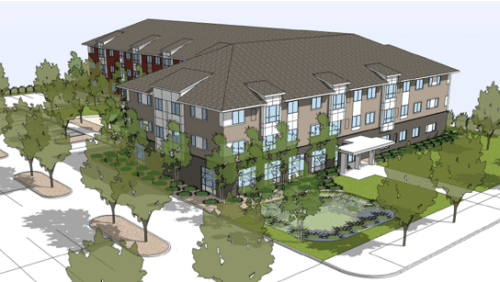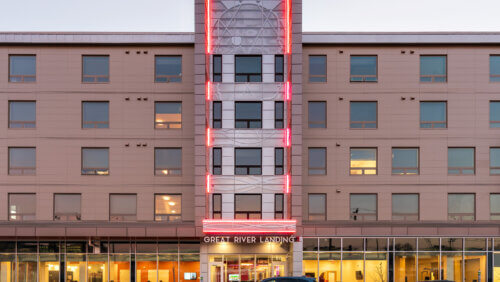Employment, Housing, Health and Wellness
Better Futures Minnesota is the service provider for Great River Landing, a 77-unit of homes for former offenders. We interviewed Thomas Adams the Executive Director of Better Futures about the barriers ex-offenders face and how Better Futures tries to pull this population out of a cycle of despair.
- What is the situation like for people who come out of prison? How hard is it for them to find jobs or a place to live?
It’s important to note that not everyone coming out of prison needs the same amount of support. Studies have shown that single men typically need more support than others and men of color typically need more support than others. We serve men who are assessed as moderate to moderate high risk for recidivism (returning to prison). Employment, housing, and health and wellness are the three most significant influencers on stability for men exiting prison. The recent state law referred as ‘Ban the Box’ has removed criminal history questions from job applications. It does not remove the question from being asked during the interview process. We have found that because of felony convictions, the men we serve are often offered jobs well below the competitive rate. They’ve been told they need to ‘prove’ themselves. Finding a minimum wage job immediately after incarceration has not proven difficult for the men we serve. The challenge is that minimum wage jobs are not living wage jobs when men have restitution and child support payments. Keeping a job immediately after incarceration has proven to be more of a challenge for the men we serve. This is due primarily to untreated mental health trauma and untreated physical health needs. We consider an adult that does not have a lease or mortgage in his/her name as homeless. This is because that adult is an ‘argument away’ from being homeless. The men we serve have extremely difficult times finding housing. With the exception of a few ‘pilot’ programs, individuals with felony backgrounds are not eligible to live in public housing. Most housing applications with private owners/developers have a criminal background check and a felony conviction is often times an immediate disqualifier. Without a stable job and/or housing, the downward spiral of bad decision-making starts and individuals are soon on the path toward re-incarceration.
- We shared some information from the 2015 Homelessness survey of the Wilder Foundation. We learned that 73 percent of homeless youth are persons of color. Are there such extreme racial disparities among the ex-offender community?
Homeless is a result of many inter-related factors (poor health, lack of family support, under or uneducated, incarceration, unemployed, poverty, etc.). Unfortunately African Americans are disproportionately represented in in many of these categories and as such are disproportionately homeless.
- What is the recidivism rate for ex-offenders that don’t find work or housing?
Recidivism rates for men who are chronically unemployed, homeless, with multiple felonies have been calculated as high as 68 percent.
- How did you get involved with Beacon to build Great River Landing? What makes it so difficult for ex-offenders to find housing?
Beacon released a RFP looking for service providers who are experience and success working with adults who’ve recently been released from incarcerations. Better Futures Minnesota successfully responded to the RFP as was chosen to be a vendor for Great River Landing. The multiple challenges the individuals who been released from incarceration make it very difficult to find housing for them. In addition, the Twin Cities metro area has very low vacancy rate. This makes housing very competitive and in an environment that is already difficult, having a felony conviction makes it housing options that much more difficult for those with felony backgrounds.
- How big of a problem is homelessness among ex-offenders?
I’m not sure of the stats on this but the MN Department of Corrections (DOC) has listed housing as a significant barrier to successful re-entry for individuals being released from incarceration.
- You’re building Great River Landing in the North Loop, which has become a trendy neighborhood over the last decade. Have you received any flak in the neighborhood for building the residence there?
The North Loop Neighborhood Association has been extremely supportive of the not only the concept but the REALITY of GRL. In addition, Mayor Jacob Frey in his role as a Council Member and Former Council Member Blong Yang were both very supportive of Great River Landing.
- How does someone connect with your program?
Individuals who are interested in our model should review our eligibility criteria at http://betterfuturesminnesota.com/join-us/apply/ or contact us at 612.455.6133.
- Is deconstruction widely used in construction over demolition? What are its benefits?
There are multiple benefits of deconstruction: it keeps our air and water clean by reducing Green House Gas emission and the amount of debris buried in landfills; it’s a job creating by creating 7x more jobs than demolition; it contributes to a circular economy through recycling, reuse, and resale of materials. Deconstruction is much more prevalent on the east and west coast and in the greater Chicago area primarily due to incentives (tax breaks, higher landfill fees, etc.) and ordinances requiring deconstruction. We are in support of incentives and ordinances being implemented in the Twin Cities.
- Better Futures will provide services at Great River Landing. What kind of services will you offer?
We will provide life-skill coaching/intensive case management, workforce development training, occupational certification, access to mental and chemical health support, fathering classes, family reunification support, and employment.


